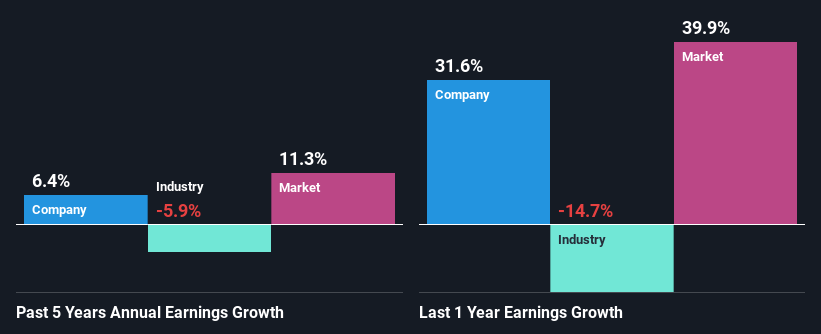Is Weakness In Collins Foods Limited (ASX:CKF) Stock A Sign That The Market Could be Wrong Given Its Strong Financial Prospects?
With its stock down 10% over the past three months, it is easy to disregard Collins Foods (ASX:CKF). However, a closer look at its sound financials might cause you to think again. Given that fundamentals usually drive long-term market outcomes, the company is worth looking at. Particularly, we will be paying attention to Collins Foods' ROE today.
Return on Equity or ROE is a test of how effectively a company is growing its value and managing investors’ money. Simply put, it is used to assess the profitability of a company in relation to its equity capital.
Check out our latest analysis for Collins Foods
How Is ROE Calculated?
The formula for ROE is:
Return on Equity = Net Profit (from continuing operations) ÷ Shareholders' Equity
So, based on the above formula, the ROE for Collins Foods is:
11% = AU$43m ÷ AU$376m (Based on the trailing twelve months to October 2021).
The 'return' is the profit over the last twelve months. That means that for every A$1 worth of shareholders' equity, the company generated A$0.11 in profit.
What Is The Relationship Between ROE And Earnings Growth?
So far, we've learned that ROE is a measure of a company's profitability. We now need to evaluate how much profit the company reinvests or "retains" for future growth which then gives us an idea about the growth potential of the company. Generally speaking, other things being equal, firms with a high return on equity and profit retention, have a higher growth rate than firms that don’t share these attributes.
A Side By Side comparison of Collins Foods' Earnings Growth And 11% ROE
To start with, Collins Foods' ROE looks acceptable. And on comparing with the industry, we found that the the average industry ROE is similar at 10%. Consequently, this likely laid the ground for the decent growth of 6.4% seen over the past five years by Collins Foods.
When you consider the fact that the industry earnings have shrunk at a rate of 5.9% in the same period, the company's net income growth is pretty remarkable.
The basis for attaching value to a company is, to a great extent, tied to its earnings growth. What investors need to determine next is if the expected earnings growth, or the lack of it, is already built into the share price. Doing so will help them establish if the stock's future looks promising or ominous. Is CKF fairly valued? This infographic on the company's intrinsic value has everything you need to know.
Is Collins Foods Using Its Retained Earnings Effectively?
The high three-year median payout ratio of 68% (or a retention ratio of 32%) for Collins Foods suggests that the company's growth wasn't really hampered despite it returning most of its income to its shareholders.
Moreover, Collins Foods is determined to keep sharing its profits with shareholders which we infer from its long history of paying a dividend for at least ten years. Upon studying the latest analysts' consensus data, we found that the company is expected to keep paying out approximately 61% of its profits over the next three years. However, Collins Foods' ROE is predicted to rise to 17% despite there being no anticipated change in its payout ratio.
Summary
Overall, we are quite pleased with Collins Foods' performance. In particular, its high ROE is quite noteworthy and also the probable explanation behind its considerable earnings growth. Yet, the company is retaining a small portion of its profits. Which means that the company has been able to grow its earnings in spite of it, so that's not too bad. With that said, the latest industry analyst forecasts reveal that the company's earnings are expected to accelerate. To know more about the latest analysts predictions for the company, check out this visualization of analyst forecasts for the company.
Have feedback on this article? Concerned about the content? Get in touch with us directly. Alternatively, email editorial-team (at) simplywallst.com.
This article by Simply Wall St is general in nature. We provide commentary based on historical data and analyst forecasts only using an unbiased methodology and our articles are not intended to be financial advice. It does not constitute a recommendation to buy or sell any stock, and does not take account of your objectives, or your financial situation. We aim to bring you long-term focused analysis driven by fundamental data. Note that our analysis may not factor in the latest price-sensitive company announcements or qualitative material. Simply Wall St has no position in any stocks mentioned.

 Yahoo Finance
Yahoo Finance 
